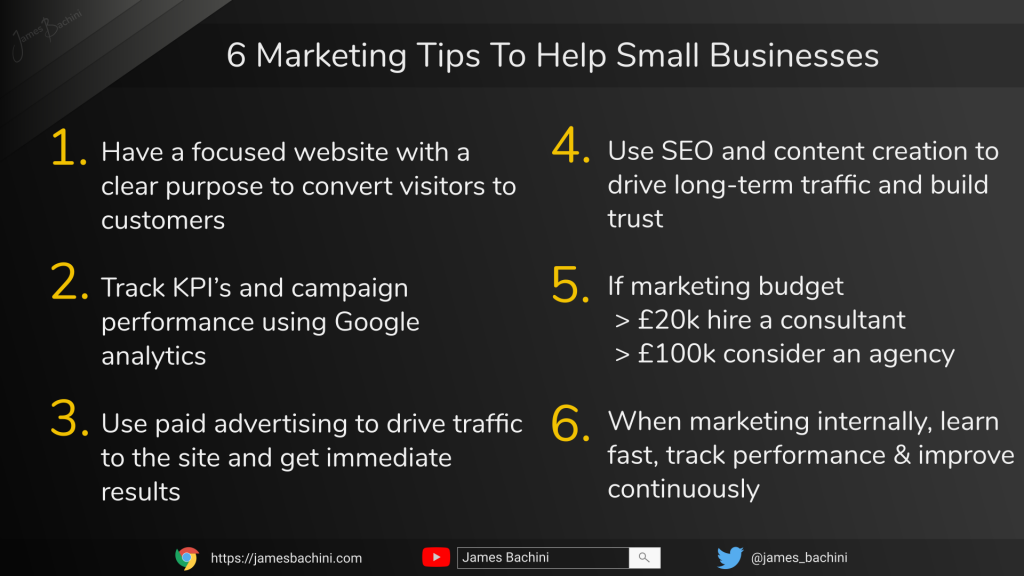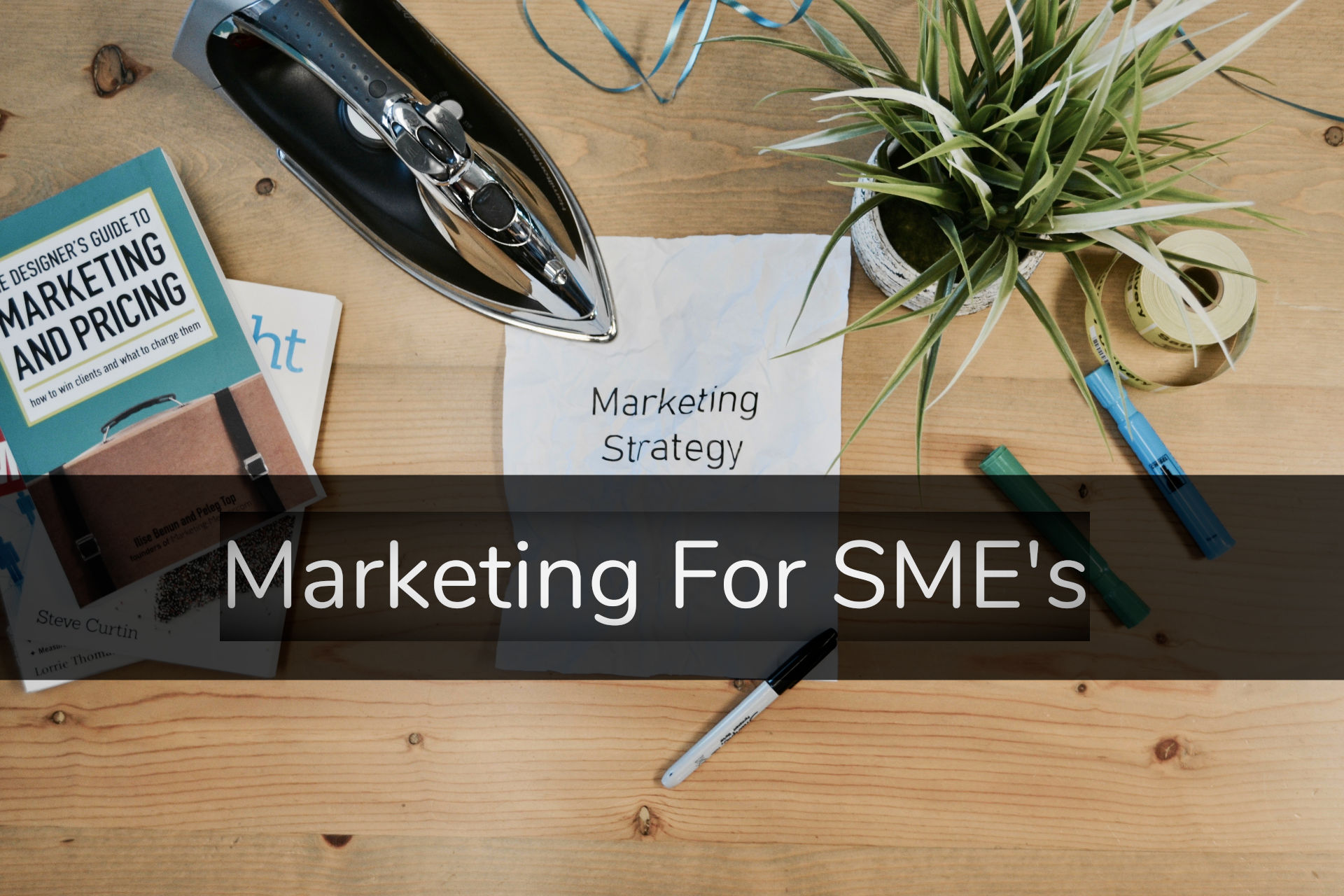This article provides marketing help for small businesses that want to develop an effective digital marketing strategy. The first section is devoted to what companies can do internally and where to start. The second section is for SMEs with annual marketing budgets greater than £20,000 ($25,000) that could leverage external consultants and agencies.

Running Internal Online Marketing for SMEs
The barrier to entry for online marketing is lower than ever and with a little bit of time and effort most small companies should be able to generate some results.
A fancy website doesn’t equate to effective marketing and generating customers. As marketers we need to drive people to that website and create awareness and demand for our products and services.
Effective marketing either takes time or money. There is no way around this. Companies either need to pay for ads or put time into building searchable content and a social media presence.
Website Design, Branding and Content Management
If you don’t have a website already then head over to https://wordpress.com
You can get a free site and then upgrade to one with a custom domain for less than £5/month. It’s easy to set up and anyone can create a site and keep it updated with WordPress. Currently 37% of the web is powered by wordpress and it’s the ideal solution for small business owners that don’t want to rely on external web developers.
If you have previously had an external company design your site then ask them if there’s a content management system (CMS) which you can use because you want to update it regularly with new content. If they can’t provide this, move across to WordPress. Also make sure your site looks great on a mobile device as there’s more mobile traffic than desktop now.
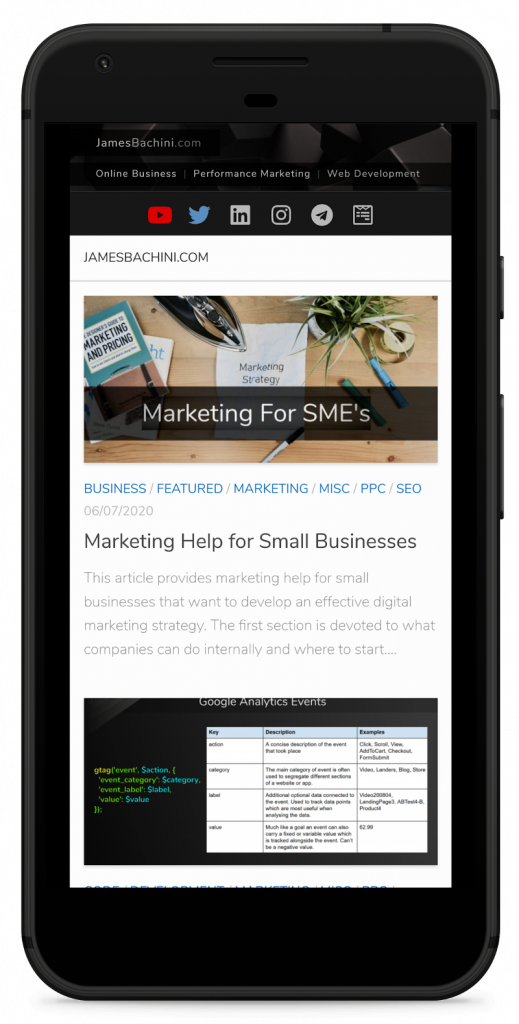
Branding
It’s important to create a recognisable brand image for everything you do online. This should include at a minimum a logo, font and colour scheme.
This means that the content we are putting on social media matches the website and the email footer and the ads. Everything is streamlined to provide a fluid professional image.
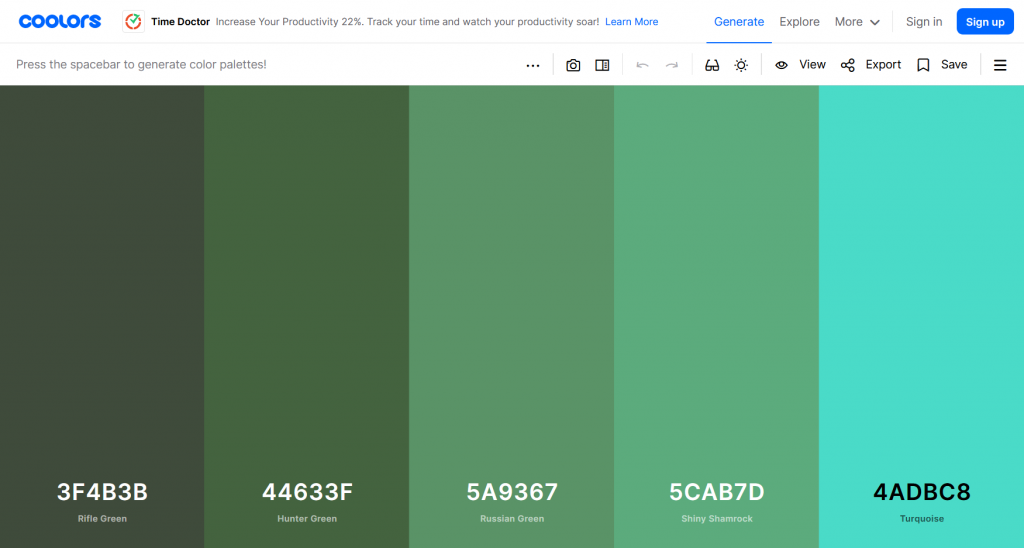
For graphics, technically minded people can use free software like inkscape to create logos and header images. Otherwise hire a single person to create a media pack including logo, social media header images and anything you need for the website. Someone from Upwork or Fiverr should be able to do this for less than £100.
Give the designer your colour scheme and as much information as possible about the image you want to portray. Check previous work and make sure you can check and approve the artwork before making payment. Make sure you are 100% happy with the designs and get the master files as well so that any changes can be made by another designer in the future if necessary.
Social Media Accounts
Different social media networks have different demographics. Focus on the main ones which are relevant to your business and where your customers spend their time.
| Aging boomer and older demographic. Business users can set up a Facebook page for their business. Don’t expect much organic reach without promoting it on your personal profile or running ads. Facebook groups can provide insights and connections in particular industries. | |
| Younger millennial demographic. Image quality focused. Business users can set up a separate business account and switch between them in the app. Ads can be run from Facebook Ads as they own Instagram. | |
| Youtube | A video platform. Video marketing is a difficult skill to master but if you have the ability to create content then it can set aside your company from the competition. A good way to build trust and consumer confidence. Setup a Youtube channel specifically for your business. |
| Professional demographics. Easy to build an audience by connecting with other users. Can be used as a content syndication platform by posting articles, case studies. Also good for hiring and finding talent. Can set up a company page and then link employees. | |
| Boomer demographic. Good social reach. A discovery platform where people generally go to connect with people they don’t know rather than friends or family. Setup a separate twitter account which is easy to switch between in the app or on the website. | |
| TikTok | Millennial/GenZ demographic with short video content. Huge organic reach and opportunities on their new ad platform. Setup a separate account for your business or use a personal account to promote your business indirectly. |
| Boomer demographic. A content syndication platform. Good for organic outreach and reaching a new audience. Look for relevant subreddits to connect and communicate with. | |
| Female demographic. Share product images and visually inspiring content. |
You don’t need accounts on every social media platform. If your products are B2B then there’s little point putting time and effort into TikTok. However if your products are aimed at people in their late teens and early 20’s this might be the perfect place to start focusing promotions.
Corporate email sends a professional image. If you don’t have this setup already you can create a [email protected] email address using the company you registered your domain name with. For a more feature rich interface check out Google suites which requires a bit more complicated setup but enables gmail for business along with other features.
Tracking & Analytics
At a minimum you need Google Analytics on your website. This will enable you to track and assess the performance of all your marketing efforts. If you are using WordPress then there’s a plugin available if not then it’s just a matter of copying and pasting the snippet onto the template pages of your site.
It is important to define your KPI’s and setup “goals” for these KPI’s in Google analytics.
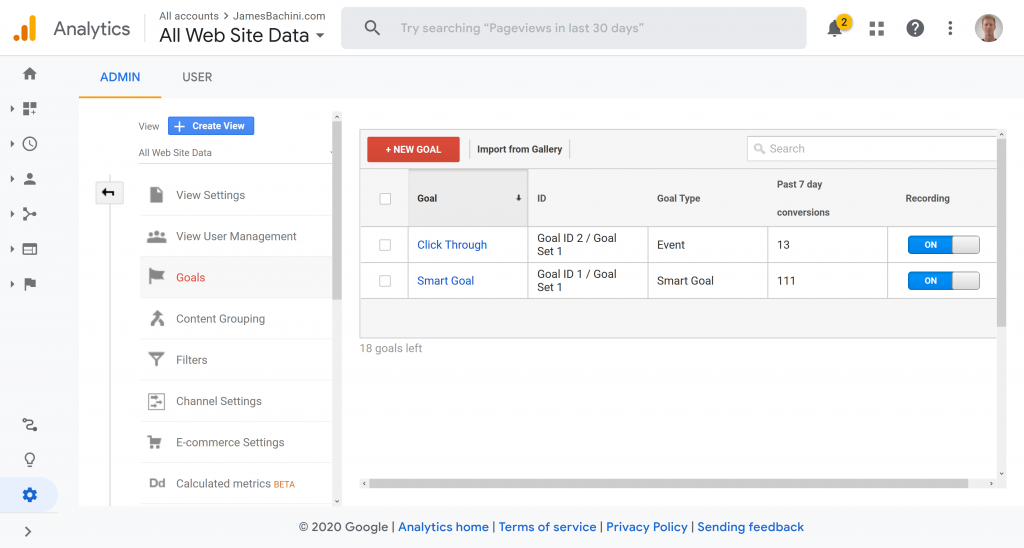
What is your website designed to do and how can we track that? Examples could be:
- A visit to the contact page with the telephone number
- A shopping cart checkout
- A contact form completed
Once setup you can use tracking variables like
https://yourdomain.com/?utm_source=facebookads&utm_medium=socialad&utm_campaign=facebookCampaign1
This can then be tracked directly in the analytics platform. Google analytics is a complex tracking system which can seem overwhelming but tracking performance is critical to optimising marketing efforts over time. It allows you to see what is working and what isn’t so you can reiterate and allocate budgets and time accordingly.
Sales Funnel
90%+ of SME websites exist just to tell you about the company. There’s no clear conversion funnel or direct method of turning visitors into customers.
A conversion funnel may be as simple as having a call to action at the end of every page leading to a contact form. It could be something more advanced like a dedicated landing page offering something in return for an email address that you can follow up with via a sales process.
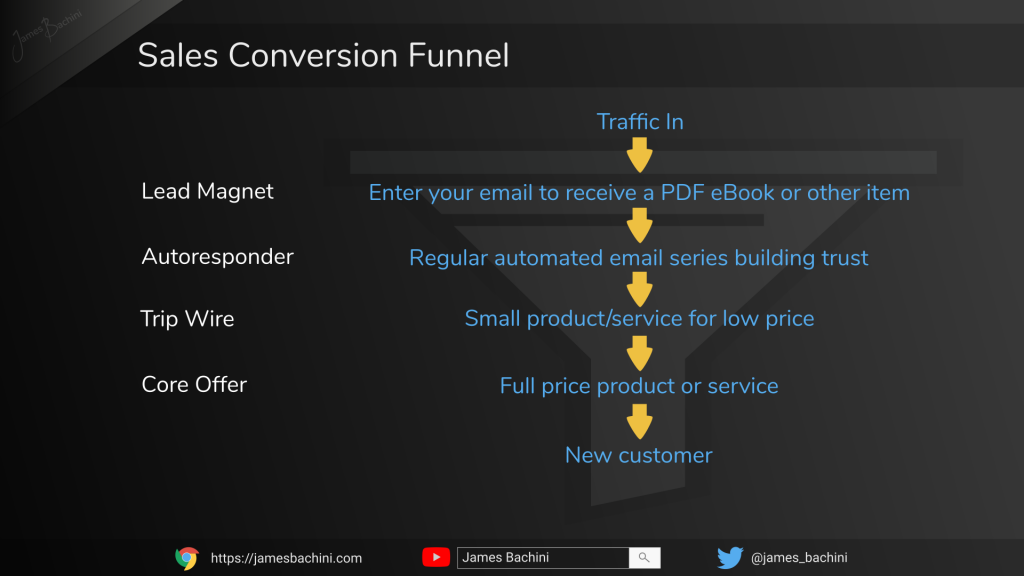
A site that converts more visitors to customers can afford to spend more on advertising and will compete better in the long-term.
A website that is designed around customers needs and helping them will perform better than a general “about us” website. Visitors don’t care about your business they care about what you can do for them
Paid Traffic
Paid traffic provides near-instant measurable results. All paid traffic should be directed to your website with analytics tracking variables added so you can accurately assess performance.
The two biggest ad platforms are Google Ads and Facebook Ads.
Google Ads
The Google Ads platform includes:
- Search engine paid ads also known as pay per click or PPC ads
- Display network banner ads
- Youtube video ads
To start with I’d recommend setting up just Google PPC ads targeting keyword phrases that your customers would be searching for with direct intent to purchase. Use brackets to do exact match keywords to start with and prevent Google charging you for irrelevant traffic.
A bike shop might bid on the following terms for example.
Don’t assume at any point that Google’s default settings when creating a campaign are there to help you. The platform is designed and optimised to sell as much ad inventory as possible at the highest price possible. Their interests aren’t aligned with your own.
For most companies it will make sense to target a specific region. If your company is most competitive in a certain town then you can target that town specifically.
Don’t allow Google to set the bid amount and campaign budget. Put in a daily budget well below what you are comfortable spending to start with and a bid of 0.32 per click. If after 3 days you are hitting your daily budget cap then reduce the bid in half. If it’s not picking up much traffic and your average ad position and impression share percentage is low then try increasing the bid 10%, once per day, until you start hitting budget.

Facebook Ads
To run facebook ads you need a facebook page and an advertising account. These can both be setup from:
Video ads work best on Facebook but you can run static image ads as well. The easiest but perhaps least effective way to set up a campaign is to use stock images with text descriptions and headlines about your products.
Facebook advertising is a disruptive platform. Noone goes on Facebook to look at ads, they are there to see family and friends pictures and interact with people they know.
Your ads need to be compelling enough to draw them away from the platform to interact with your business.
Niche products and services that have consumer appeal such as clothes, gadgets, hobbyist products, consumer electronics all do well. Local services with broad appeal such as gardeners, cleaners, decorators and restaurants can generate business on Facebook as well.
The platform excels and is sometimes criticised for its laser targeting. Marketers can target people of a certain age, who are interested in certain topics and live within a specific radius of a particular postcode. This is as terrifying as it is powerful and it offers endless opportunities for creative performance marketing.
When setting up campaigns create multiple ad sets per campaign with different demographic and interest targeting. Set low daily budgets of £5 per ad set and focus specifically on Facebook feed post ads 2-3 days. Then expand these, place max bid ceilings and create more variations of adsets once you have some insights into what is working.
Facebook has industry leading machine learning algorithms. If you have the ability to set up the facebook pixel with your KPI goals then you can train the pixel and run broad targeted ads letting Facebook optimise the traffic based on the training data. This scales and works really well if you have enough data (roughly more than 20 conversions per day) to train the pixel.
Free Traffic
SEO – Search Engine Optimisation
Search engine optimisation is the process of moving your site up the organic, or free, Google search engine results pages.
SEO is a marathon not a sprint and even the best SEO experts wouldn’t expect any significant results within the first 6-12 months when working with a new or low traffic site
To target organic traffic we need to start with keyword research. What search terms do we want to rank for?
It’s important to be realistic here. If you have an unknown site and there’s a lot of competition from domains you recognise in the results then it might not be possible to rank organically. Start by niching down and targeting the “long tail” of search results.
There are two good ways that you can find search terms. One is to type a seed phrase into google related to your business and see what autosuggest terms pop up. The second is to search for a term and scroll down to the “related searches” section in the results.
We can then get keyword search volumes and other suggestions from https://ads.google.com/aw/keywordplanner/

The point of this is to find search terms that aren’t competitive but do get some search traffic. Once we have a target keyword we need to assess the competition.
Signs of low competition search terms:-
- Is the top result an unknown site you haven’t heard of previously?
- Does the top result have high quality media such as images and videos?
- Does the top result have a good layout? Contents, sub-headings, internal links
- Is the top result inundated with ads?
- Is a Quora/Forum post in the search results?
- Are there posts that are 2+ years old in the results?
We then create content to specifically rank for that term.
The best content is a long-form blog post like the one you are reading. This is particularly long and in-depth but for lower competition keywords it’s possible to rank with less than 800 words. For medium difficulty keywords focus on 1500+ articles which include rich media such as images, infographics and video. For the most difficult keywords it’s best to create a central “pillar post” of 3000+ keywords and then have sub-topic articles linked from that.
As you can see the “free” organic traffic isn’t exactly free as it takes a lot of time and effort to create great content that deserves to be at the top of the search engine results.
Finally it’s worth setting your site up in https://search.google.com/search-console
The search console will provide insights and data relating to the organic search listings.

Outreach
Outreach can be as simple as networking and connecting with other industry players on linkedin or it could be writing an article for Forbes. It’s about getting your name out there and leveraging other brands communities with your story and vision.
Press Releases
Press releases come in various forms. There’s the bulk press release software which spams your release to spammy pr sites. There’s paid promotion and editorials which can contain backlinks for SEO purposes and drive traffic to your site. And then there’s free press if you can create a compelling and interesting story related to your work.
Real press from real journalists are normally the most valuable. Getting an article on the BBC or any niche news sites can drive traffic and help with search engine traffic. The first step is to pitch your story to a journalist. Make this targeted and as newsworthy as possible.
The truth is that no one cares about your business like you do. Make it about something else that readers can relate to.
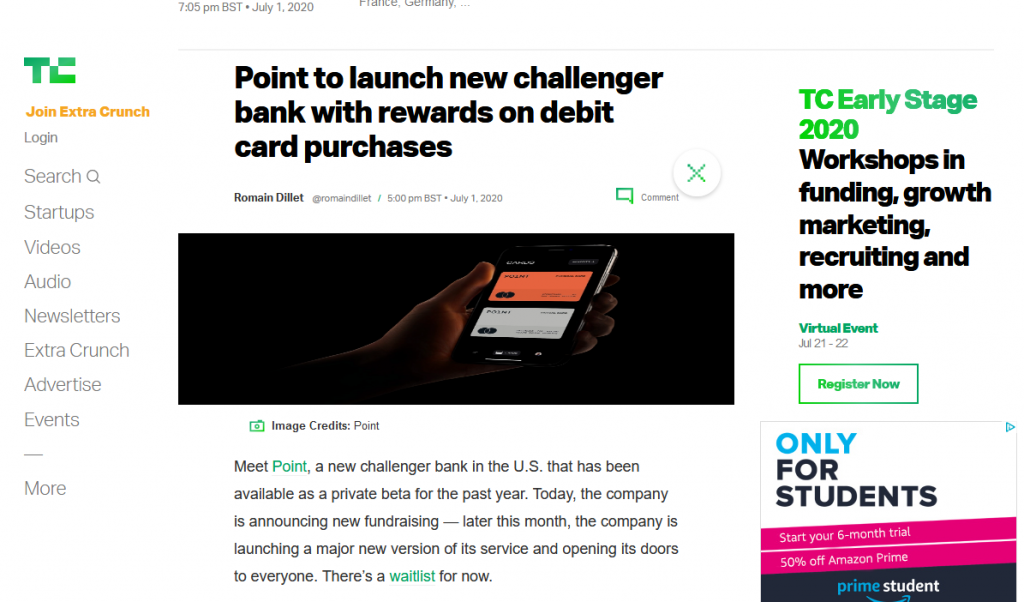
Guest Blogging
Many blogs offer to publish 3rd party work. You write the content for them (non-promotional) and they’ll publish it to their blog. This gets you in front of a new audience that might not have heard about you or your company before.
If you ask, many guest bloggers will allow you to place a backlink back to your site and even a tracking pixel for retargeting purposes in the post.
Guest blogging has become very popular in recent years and automated software has made bloggers put up their defenses to avoid spam. For best results it’s best to leverage existing connections and ask for an introduction to the best quality blogs or publications in the sector.
For more information on SEO check this comprehensive guide to creating SEO content.
Putting it all together
All of the strategies here boil down to customer acquisition. How much does it cost to acquire a customer using online (or offline) marketing?
In an ideal world SME business owners should track and know this metric. They should be able to tell you if it’s higher or lower than the previous month. Many don’t however and by focusing some resources on digital marketing you can produce measurable results and get ahead of the competition.
Finding a Marketing Consultant or Agency
If the annual marketing budget is below £20,000 ($25,000) then it doesn’t make sense to spend a large percentage of that budget on a consultant or agency. Above this amount and the value that a consultant can add by setting up ad campaigns and doing a little maintenance should pay for itself in efficiency and marketing performance.
A marketing agency will offer help from multiple employees providing a diversified range of skills to cover the entire online marketing ecosystem. A consultant may be more specialised but may also be more cost effective as they will have less overheads.
The first step to finding someone is to figure out what you need. This will require a small amount of background knowledge in the space.
At a very basic level online marketing can be broken down to the following categories.
Digital Marketing Specialist Areas
| Search Engine Optimisation (SEO) | This is the process of trying to get your website ranking higher on Google. There is literally no point in hiring someone to help with SEO unless you have a strong content strategy. Your company should be creating content regularly via blog posts, articles, videos, social media posts etc. If you aren’t producing high quality, regular content then a consultant won’t have much to work with and results will reflect that. SEO is a slow process that can take six to twelve months to gain any traction. If you want fast, guaranteed results then direct response advertising via paid ads may be a better fit. Developing content internally, combined with a good SEO consultant, can generate a long-term “free” source of new visitors via organic search engine rankings. |
| Google Ads (PPC) | Pay per click ads are shown at the top and bottom of the search results on Google and get the majority of traffic. This is a competitive arena in most industries with click costs ranging from £0.1-£20 per click. A consultant that specialises in PPC campaigns should be able to set up a campaign and then come back after a set amount of ad spend to optimise. The optimisation process is as important as the campaign setup. The company will likely need to provide insights into the keywords that should be targeted. What are the ideal terms that would bring in the most qualified traffic. Once ad spend gets to a certain level it is also worth discussing conversion rate optimisation and landing page funnels. This is the process of converting more clicks to leads and sales. PPC advertising works best when there are consumers actively searching for the products and services your company offers. |
| Social Media Ads | Social media advertising is a disruptive advertising that works well when demand needs to be created i.e. the consumers aren’t searching Google for your products. Facebook ads is the major player in this field as their ad platform offers exceptional targeting options and they have huge volumes of inventory, including Instagram. Twitter, Linkedin, TikTok & Snapchat all have advertising platforms as well but unless there’s a specific demographic on those networks that you are targeting it makes sense to start with Facebook ads. Social media ads can be run as direct response marketing and when done well you should be able to get an exact measure of ROAS (Return on ad spend). |
| Miscellaneous Marketing | There are so many factors that go into a comprehensive online marketing strategy it can be overwhelming to know where to start. Having a good website is the first step but without visitors it won’t have an impact on the business. Here are some of the things not mentioned above that an agency should be able to help with. Branding Website Design Tracking & Analytics Budget allocation and performance analysis Email marketing Social media strategy Content production Digital PR |
Marketing Strategy For SMEs With £20,000 Annual Budget
This strategy requires an internal employee or founder to put around eight hours a week into creating content and developing the marketing campaigns.
- Create content internally – Get as many employees as possible to start writing content, taking photos on their phones, documenting case studies. This can be polished later but develop a culture of creating content. No agency can come in and do this effectively for you as they wont understand your business and customers in the same way you do.
- Hire an external web designer to give your website and branding an update and refresh. Budget £2,000 for an independent web designer to do the update. You can find web designers via upwork or linkedin and ask to see previous work. Every 3-5 years it is worth doing a more major update and budget accordingly.
- Make sure at least one internal person in the company has the ability to update the website. With content management systems like wordpress this isn’t much more difficult than updating a word document. Ensure this person has the time and resources available to update the site and any social media accounts on a weekly basis.
- The remaining budget of £18,000 will be split with £15,000 on ad spend and £3,000 on a marketing professional to set up campaigns and optimise. This isn’t a huge budget so it’s likely you’ll be looking for a consultant rather than an agency. Be open about your budgets and expectations. Some consultants will work on a percentage of ad spend and this is an ideal solution for small budgets.
- The consultant/agency will likely set up initial paid advertising campaigns with some direction from you. It’s critical that they optimise the campaigns at least monthly and this is worth asking about when agreeing contracts.
How To Find A Consultant
Consultants specialise, seek out someone who has vast experience in the area you are targeting. Social media advertising is completely different to search engine optimisation and the skillset doesn’t translate automatically.
For SEO type “independent seo consultant” into Google and see who is ranking for that term in the organic listings.
For PPC take a look on Linkedin for “PPC specialist” or “PPC consultant”.
For Social Media advertising ensure you look for someone that is a specialist in running direct response paid advertising and not a social media coordinator who will be more experienced in creating social media content.
Some places to find consultants:-
Search what you are looking for + independent consultant
Use the Linkedin people search tool to search for the job role you are looking for.
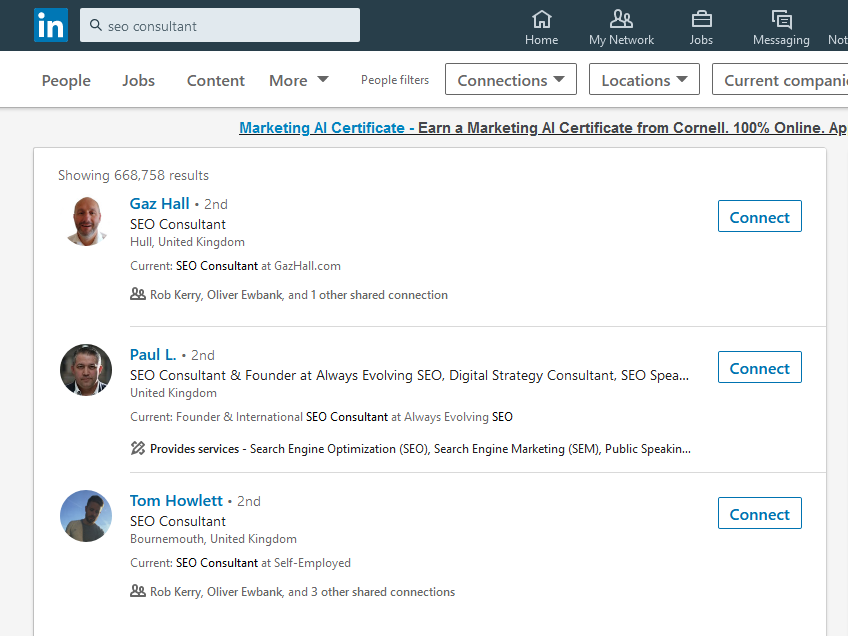
Upwork
Everyone on upwork is a consultant or freelancer so just search the keyword term.
I’d recommend turning the local filter on and not going with the cheapest option on Upwork. Look at job success and amount earned on the platform ratings.
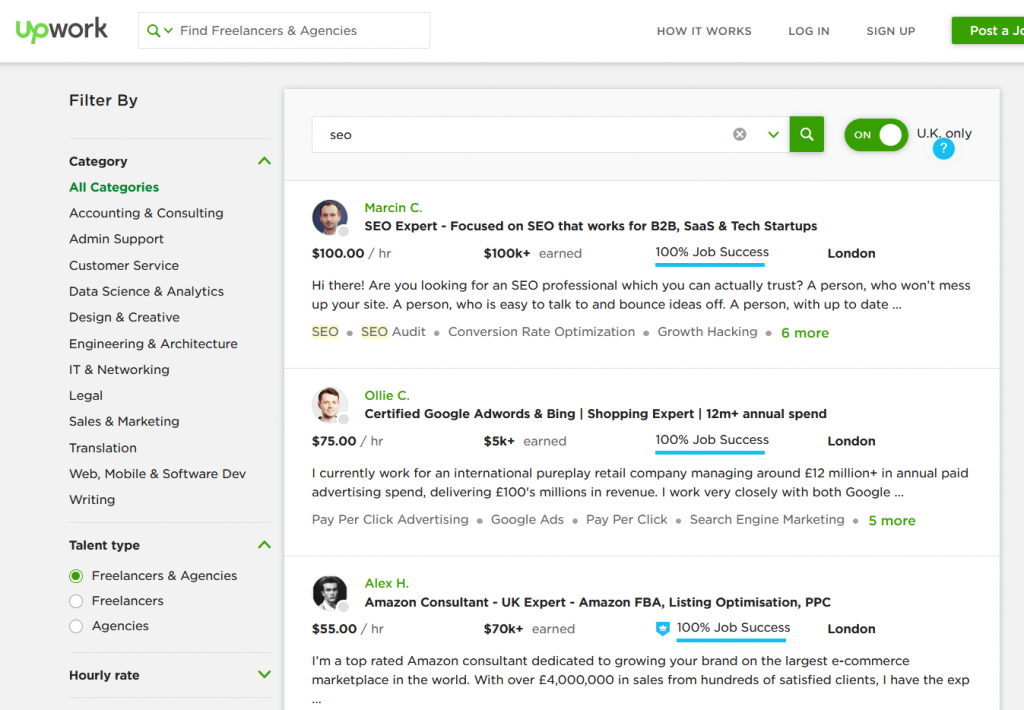
Marketing Strategy For SMEs With £100,000+ Annual Budget
When spending large amounts on marketing an agency can add enough value to justify their rates.
The benefit of using an agency over independent consultants is that they’ll have a broader range of skills that can provide a more comprehensive list of services.
The larger the agency, the more employees, the more likely they are to have every aspect of online marketing covered.
How To Find An Agency
Start at Google and try to find a company locally that you can meet face to face with. Some agencies will be more focused on branding and design while others may be more focused on performance marketing and media buying, ideally you want both.
It shocks and amazes me how many marketing agencies clearly have no idea about modern digital marketing and this you can tell pretty quickly just by looking at their website.
- Is it visually impressive?
- Is it built using modern technologies and tracking systems? Use builtwith to look under the hood.
- Does it have a conversion funnel?
- Does it have a performance focused landing page?
- Are there references, industry awards, case studies?
- What are the website metrics on majestic.com and page speed insights?
- Do you see retargeting ads after you’ve left the page?
If a marketing agency can’t get their own site right, they shouldn’t be touching yours.
Create a shortlist of the top 3-5 in your area and then contact them with the following queries:-
- What process do they recommend to set up and run the marketing strategy?
- How would they allocate your budget and would this be transparent?
- What team would be working on your marketing, age, experience?
- Can they provide references or case studies for previous related work?
Compare the responses, follow up with a video call or meeting and go with who will offer the best value and performance.
Conclusion
Online Marketing is about driving new business through customer acquisition. If you work at acquiring customers more effectively than your competition then you’ll build a long-term advantage.
6 Marketing Tips To Help Small Businesses
- Have a focused website with a clear purpose to convert visitors to customers
- Track KPI’s and campaign performance using Google analytics
- Use paid advertising to drive traffic to the site and get immediate results
- Use SEO and content creation to drive long-term traffic and build trust
- If marketing budget >£20k hire a consultant, >£100k consider an agency
- When marketing internally, learn fast, track performance & improve continuously
